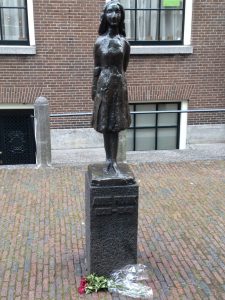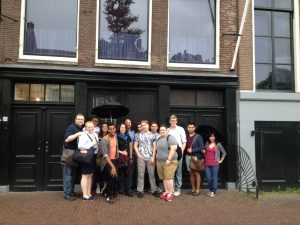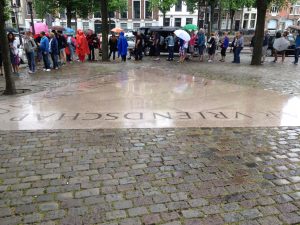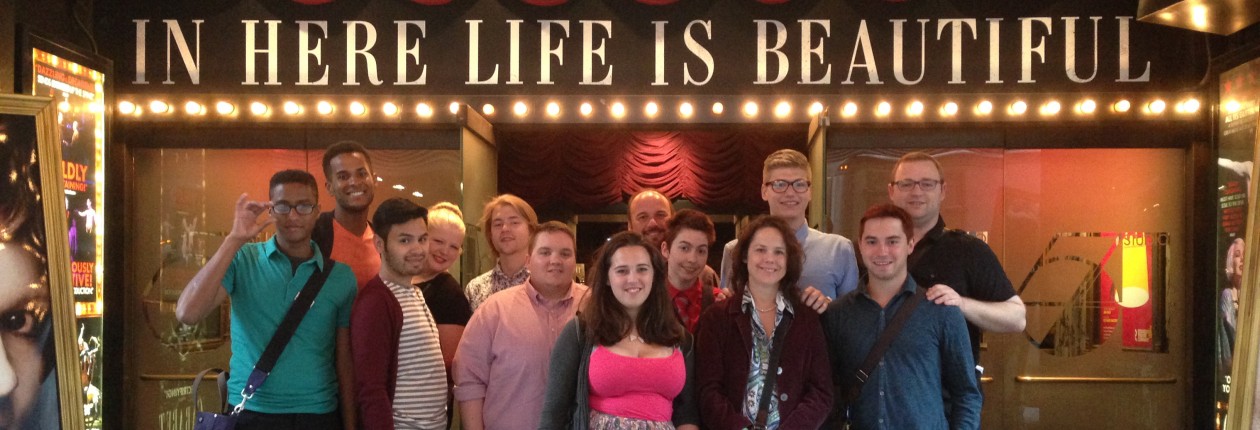By Allan Summers
Today’s adventure took us all around the city. We awoke early to head to the Ann Frank House. We arrived at the actual house and Secret Annex of Anne Frank and her family and a long line met us with more than 100 people even though it was only 9:00am. Luckily, we had purchased our tickets in advance and didn’t have to wait that long to see this historic site. For those of you who do not know, Anne Frank was a young Jewish girl who went into hiding with her family from the Nazi Party during the Second World War. It was the goal of the Nazi Party to exterminate the Jewish citizens and during their persecution Anne Frank documented her experiences as she and her family hid for about 2 years. Anne was also the author of many short stories and collected her favorite sentences while hiding in secret. On August 4, 1944 Anne, her family, and the rest of the inhabitants of the Secret Annex were arrested and processed by the Nazis. Anne would eventually die at Bergen-Belsen concentration camp in Nazi Germany at the age of 15. Of the eight residents of the Secret Annex, only one, Otto Frank, Anne’s father, survived. He was rescued from the camp only one month after Anne’s death.
A video played in the museum narrated by Anne’s childhood best friend, another survivor of Auschwitz, and in this video Jacqueline van Maarsen talks about hope and how they tried to make the best of their situations. The two were definitely lucky to have each other in those hard times. Jacqueline recalls the last time she saw Anne that she looked so “hopeless”. Anne thought that she was the last of her family to survive the camps. Unbeknownst to her (or anyone), a month later would the camp be liberated and she would be reunited with her father who was held in the infirmary. Jacqueline van Maarsen believed that had Anne known that her father was still alive, she could have held on a little longer and potentially until the liberation of the camp. I believe that hope could have given Anne the strength she needed, even if she wasn’t going to survive.
Directly out side of the Anne Frank House is another national monument called the “Homomonument”. This monument was presented to the public on September 5, 1987 to commemorate the gay men and women who lost their lives during the Second World War. Gay men and women were harshly punished and sometimes killed under Nazi rule because they “did not fit” into the Aryan identity the Nazis were trying to attain. Those sent to concentration camps were forced to wear a pink triangle on the right corner of their shirts and as well as on their pants to signify to everyone else that this person was either a homosexual or “committed same sex crimes”. Lesbian women were seen as social deviants and so they were forced to wear either black or red triangles on their clothing. Still, the Homomonument is not only meant for those queer persons who suffered in World War Two, but for any body who have been or are still persecuted and killed by political and government groups.
The monument itself is actually composed of three, pink granite, equilateral triangles connected by a band. The three triangles actually form a fourth triangle as a whole. Each point in the monument represents the past, present, or future and also points to another famous landmark in Dutch history. What I found so shocking about this monument was that it was so close to the Anne Frank House they the line continuously spilled over literally on top of the Homomonument. The general public seemed to be entirely clueless as to what all of the symbols on the ground mean, and what this kind of monument means to queers all over the world. Not to take away from the impact of the Anne Frank house, I just wanted to make note on how this landmark is literally “hiding in plain sight”.
We were let loose for the rest of the day and I chose to spend some time in the sex museum. This museum was full of very rare art that would otherwise be hidden from various cultures. We saw same sex acts in photography and art dating all the way back to the 1800s! These pieces of art would probably never be seen in a museum in the States. Cultures from all over the world were represented from the Middle East, to the Americas, all the way to Japan and Polynesia. It was amazing to see much older cultures recognize different sexualities and different sexual identities and how it can seem how we have taken steps back in censoring how we view our bodies and identities.
The last part of our day took us to the infamous Red Light District in Amsterdam. This section of the city has a very open view on sex acts and sexuality and many shops celebrated the use of sex toys and enhancers for partners of all types. This part of town is also widely known for the regulated prostitution. As we walked along the narrow streets, we peeked inside windows normally used to advertise potential partners for the night. Thankfully we weren’t solicited! The openness of all sexualities was extremely interesting. We, as Americans, have been so conditioned to turn away from nudity and from sexual exploration, so it was refreshing to see people of all ages celebrate something that can be so beautiful.
At night, I ended with some Indonesian food at a local spot. I had to try it out because it seemed that there was no shortage of Indonesian, Peruvian, or Argentinian restaurants. I can’t wait to try the other two types of dishes tomorrow. All in all, we are still on the right track to discovery and liberation. I know that I have been taking every opportunity to try something new or walk a little bit further to see the next museum. Because who knows the next time I’ll get to do this again…I may not know, but I’m not going to waste it this time around!


